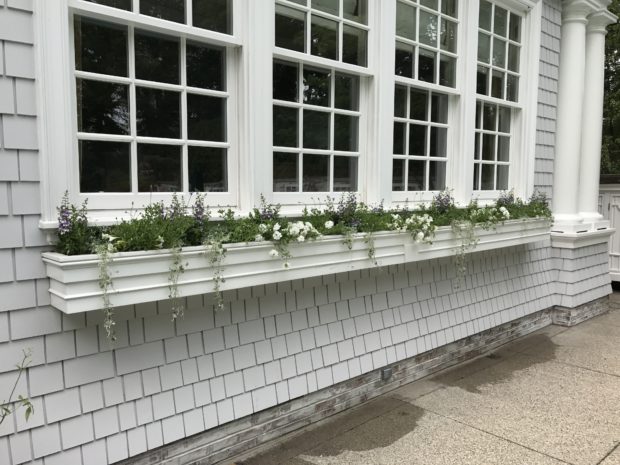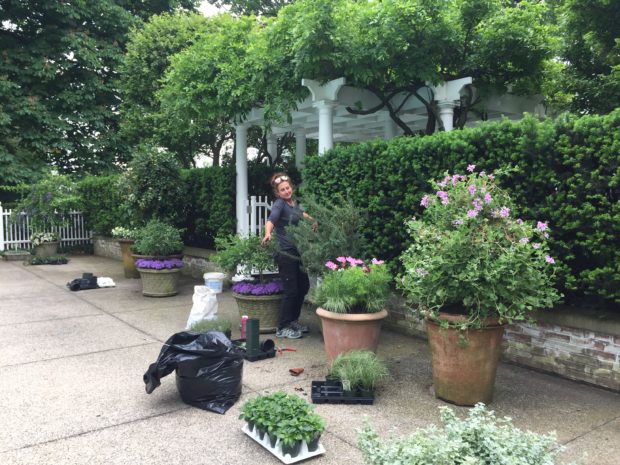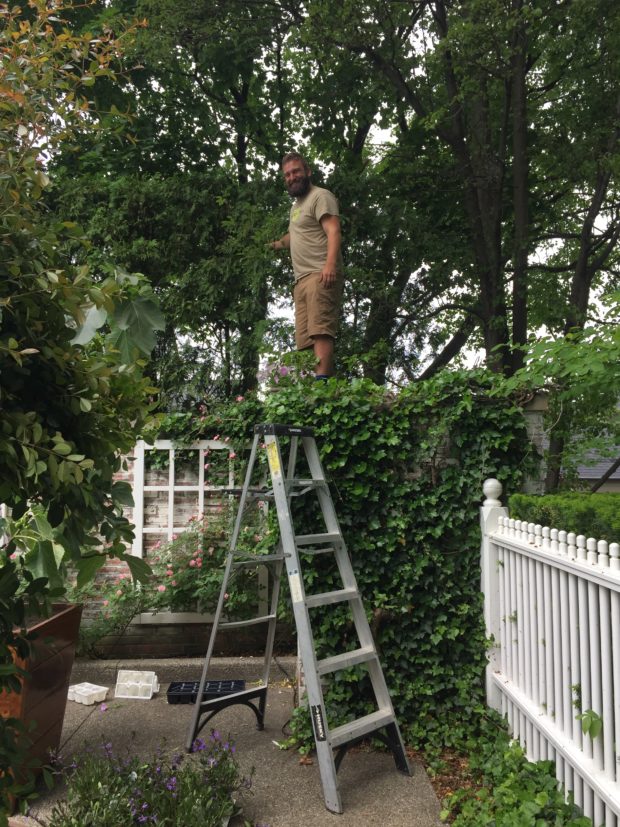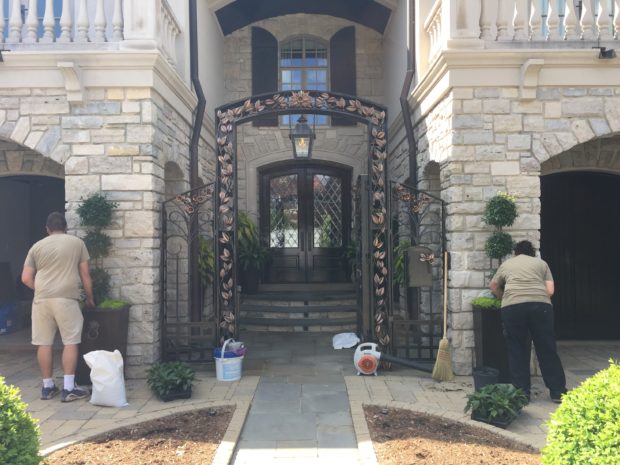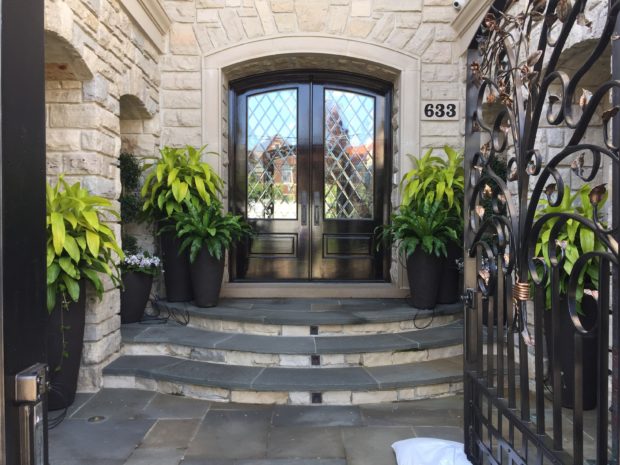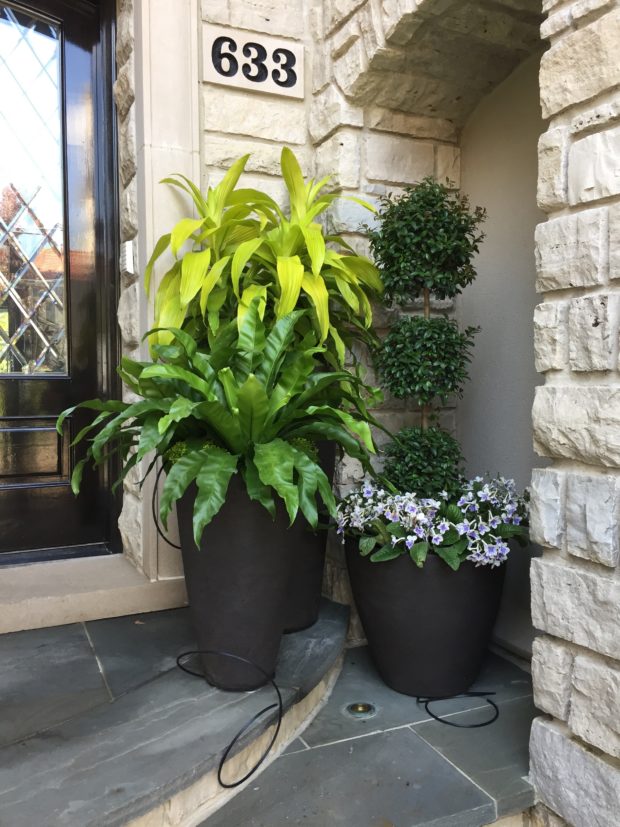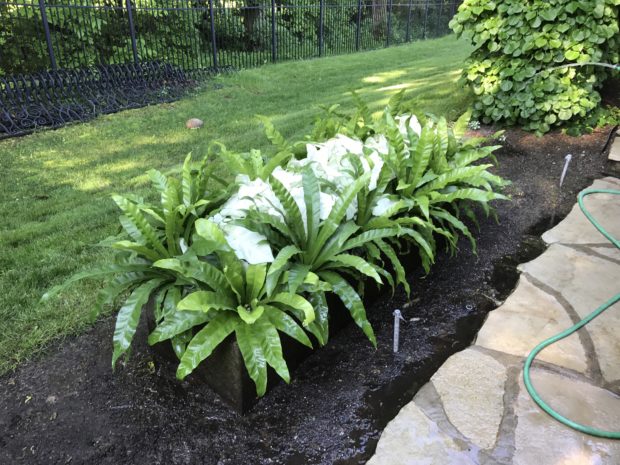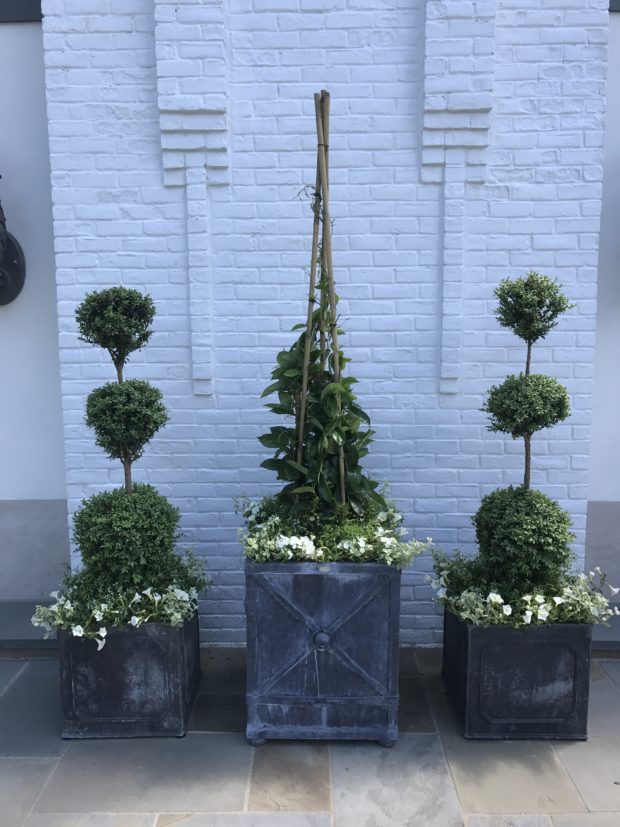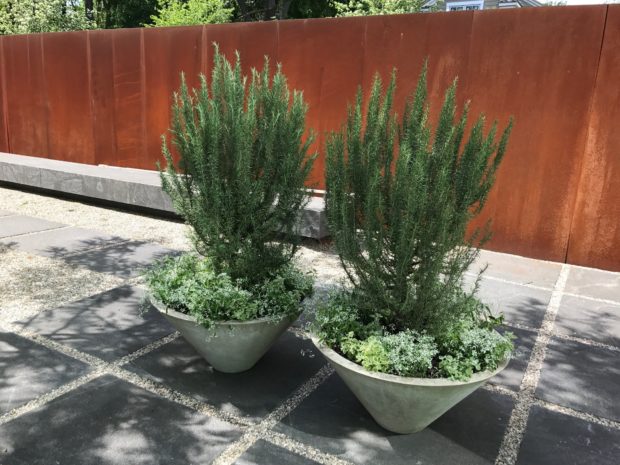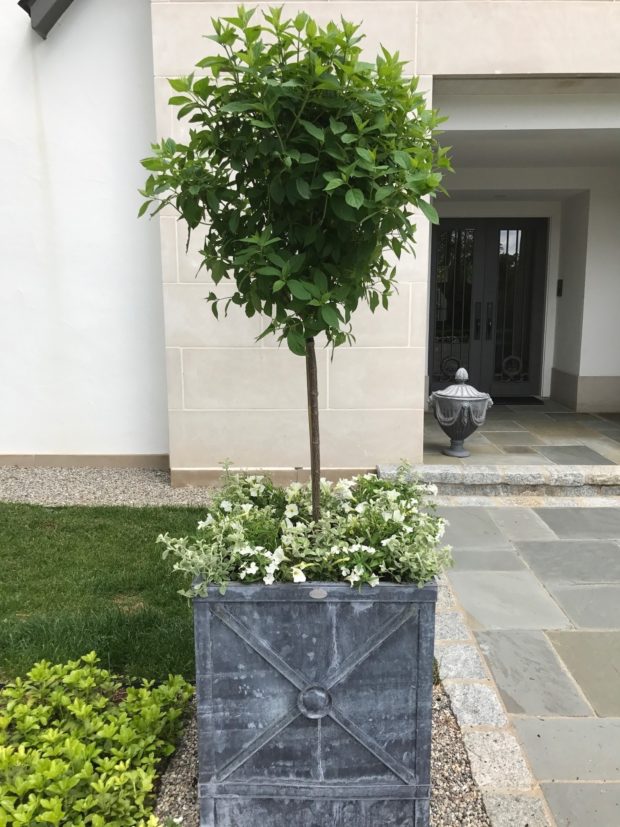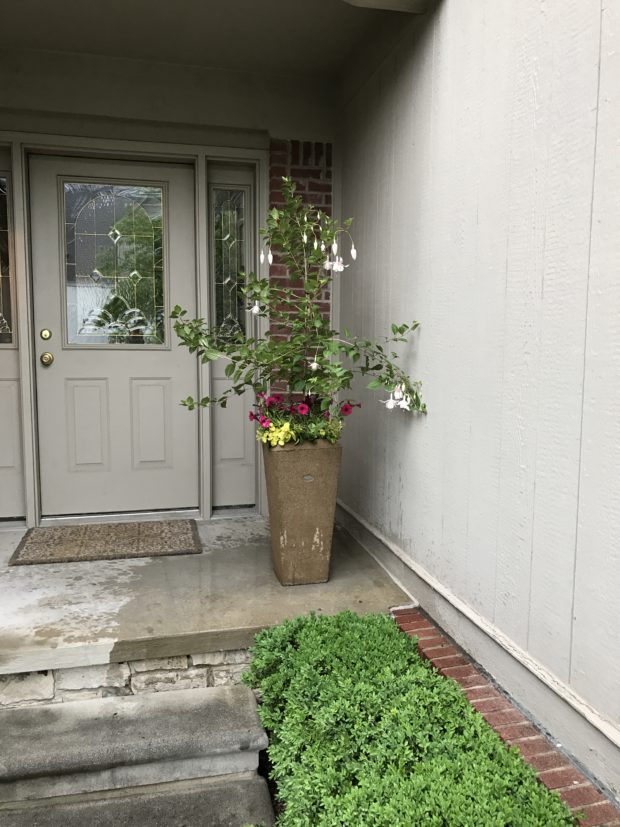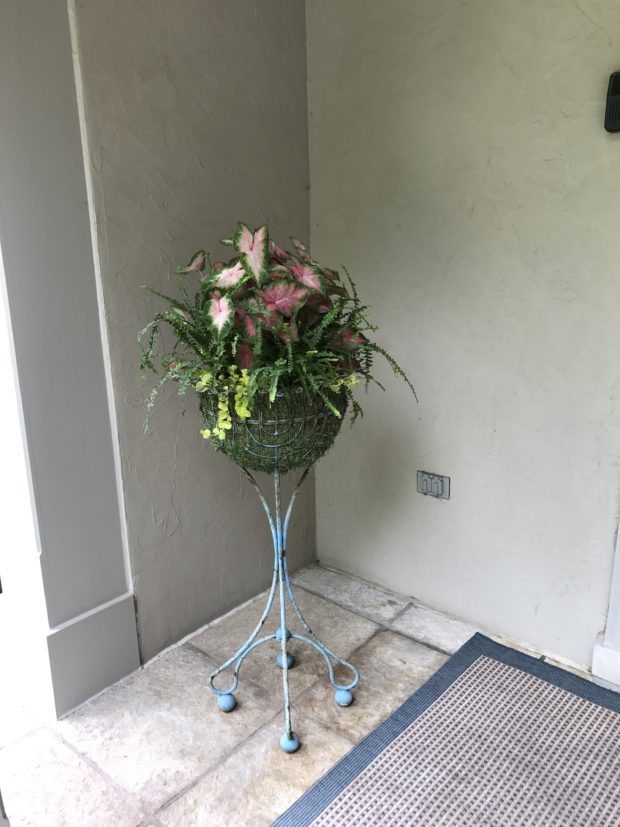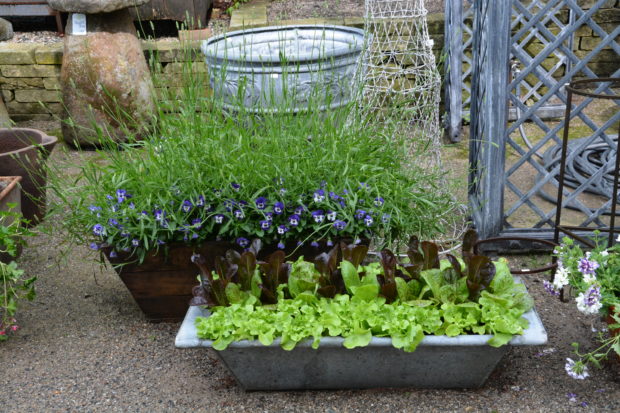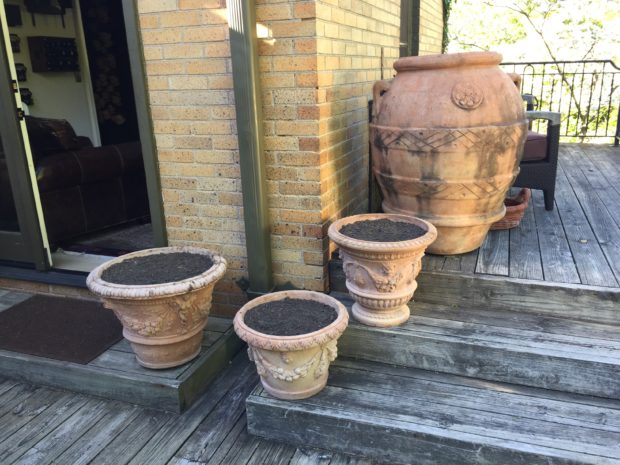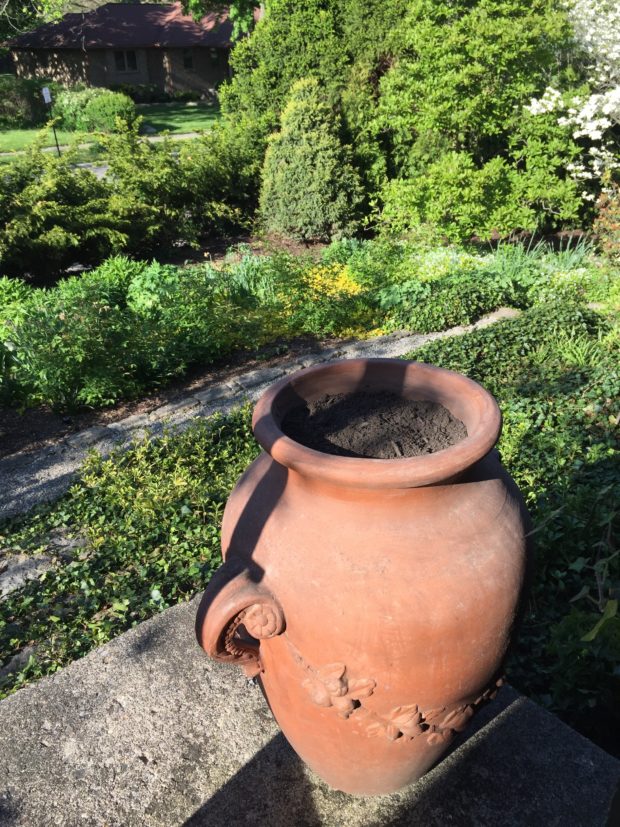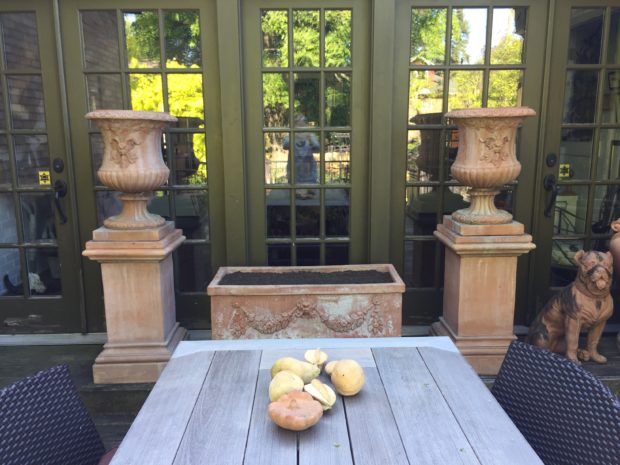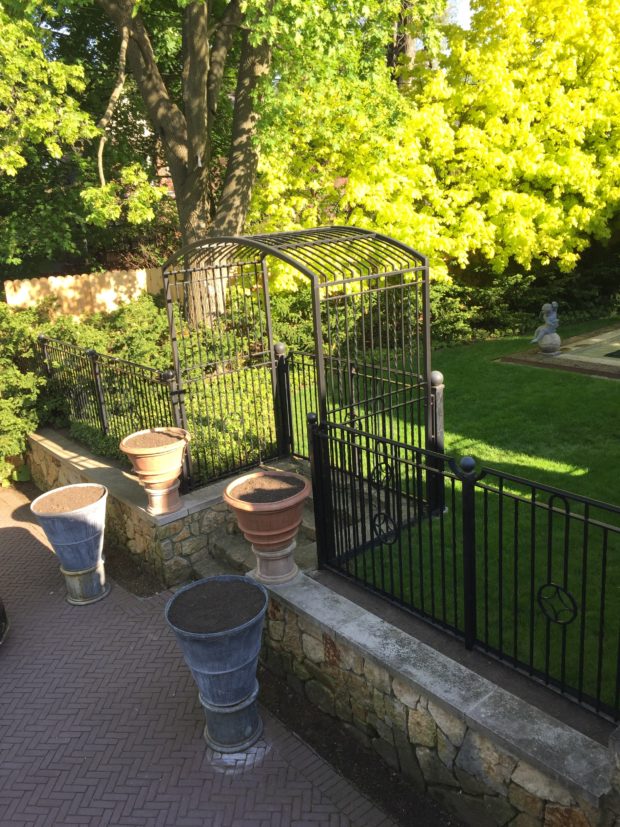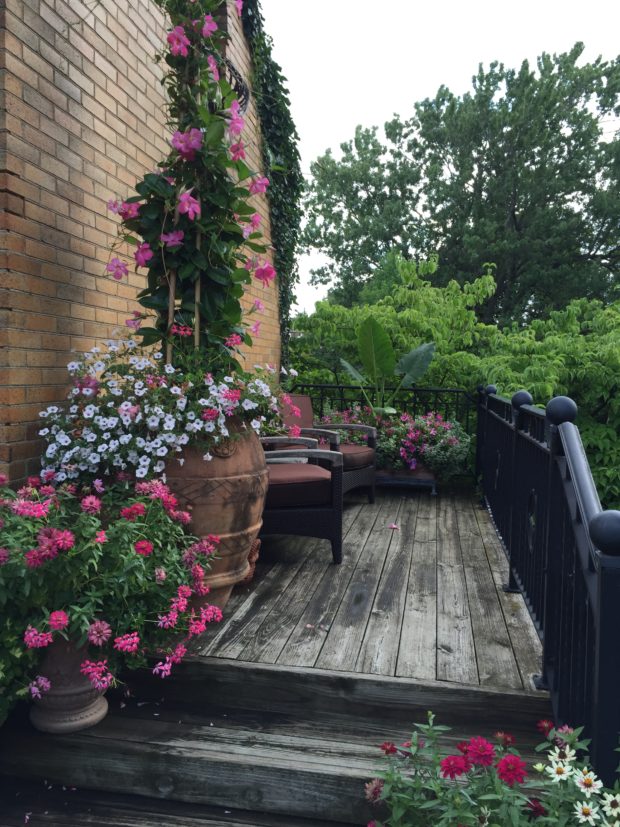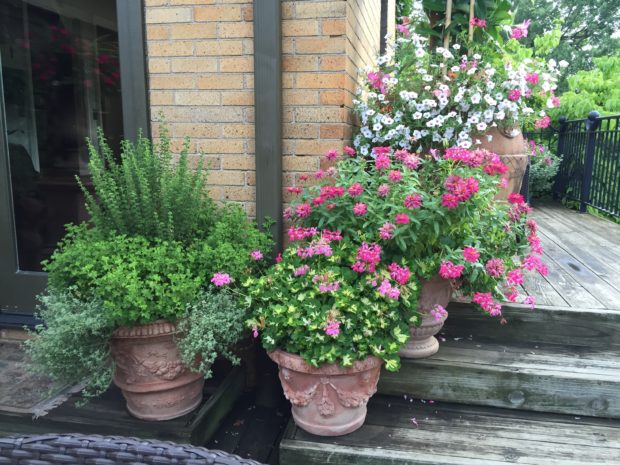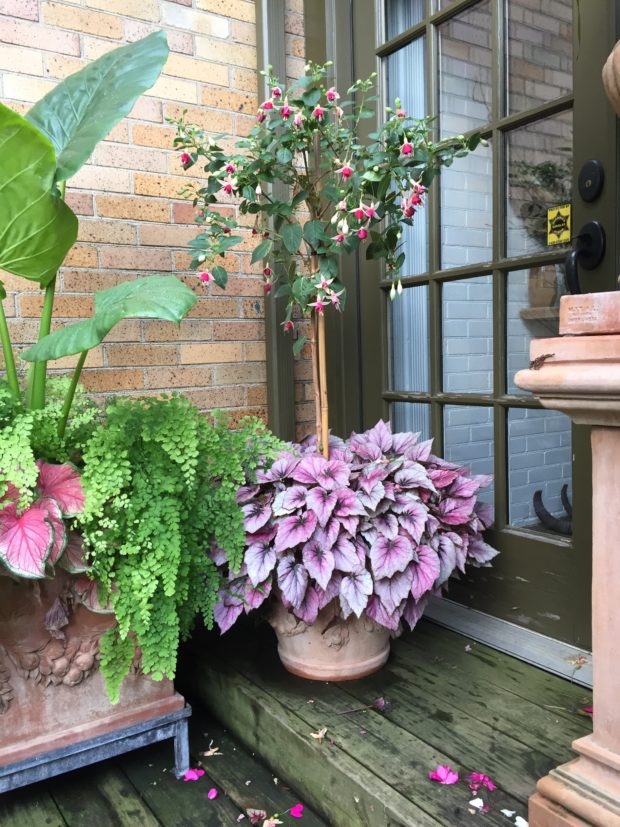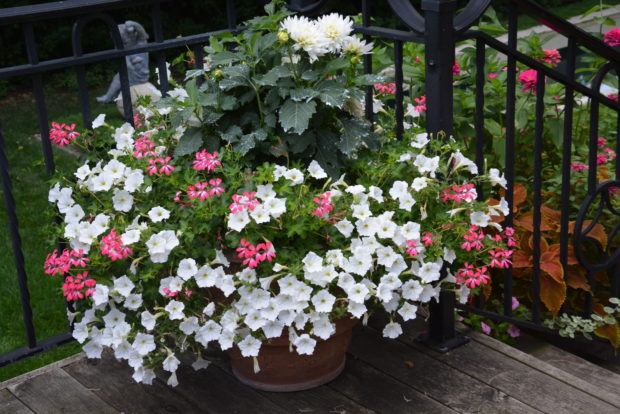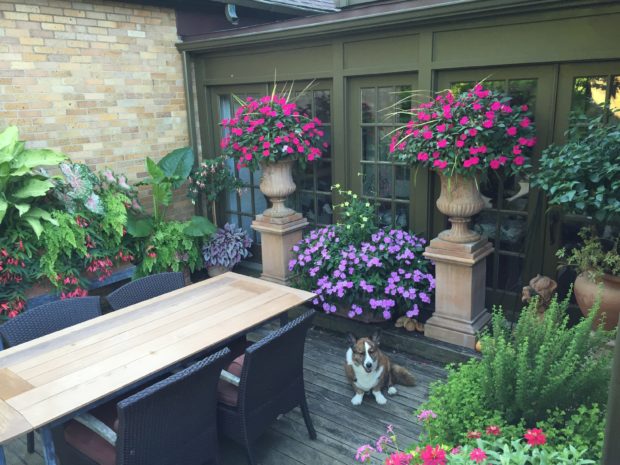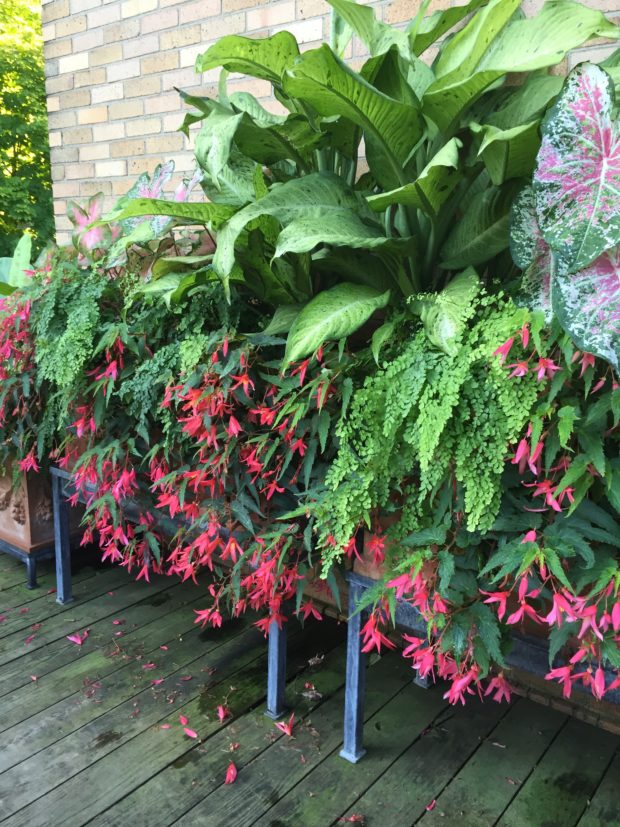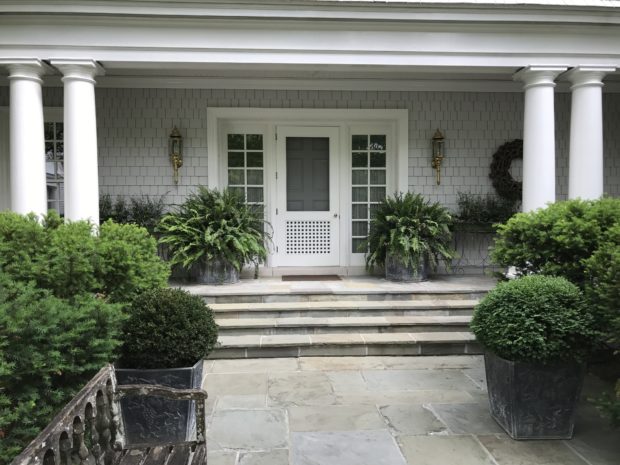 The past 9 days have been a grueling blur. Once I establish a rhythm, I plant by instinct. I trust my first thought more than the thoughts that come later. I don’t really have time to second guess my decisions, so I don’t. I cannot imagine how my crews must feel. I feel certain that they needed this Sunday off. My crews have another couple of weeks before this phase of the summer’s work is done. Their work on every project we take on makes me look good. I treasure each and every one of them. One project that always grabs me by the shoulder and gives me a good shake got planted last week. My container planting for this client dates back 20 years. In the early days, there were lots of flowers. Purples, whites, and some pale pink. Boxwood edged parterres enclosed pink roses. The early container plantings were lovely. Flowery. But like any serious gardener, her taste evolved over the years. There were changes made to the landscape as well. I was always keenly interested in what she had to say about the summer plantings each spring, and challenged by how to interpret that in a way she would like. A project of such long standing and commitment from both myself and the client is a project I treasure. Every year there would be fewer flowers, and a few more green plants. Topiary plants made their appearance. Once we had topiaries, there would be winter storage and care in a greenhouse. Green plants that would visually recall an English conservatory were a favorite of hers. Ferns would figure prominently in the mix. The ferns in the above picture were wintered many times in an unheated greenhouse. They are a beautiful size and proportion for where they are placed.
The past 9 days have been a grueling blur. Once I establish a rhythm, I plant by instinct. I trust my first thought more than the thoughts that come later. I don’t really have time to second guess my decisions, so I don’t. I cannot imagine how my crews must feel. I feel certain that they needed this Sunday off. My crews have another couple of weeks before this phase of the summer’s work is done. Their work on every project we take on makes me look good. I treasure each and every one of them. One project that always grabs me by the shoulder and gives me a good shake got planted last week. My container planting for this client dates back 20 years. In the early days, there were lots of flowers. Purples, whites, and some pale pink. Boxwood edged parterres enclosed pink roses. The early container plantings were lovely. Flowery. But like any serious gardener, her taste evolved over the years. There were changes made to the landscape as well. I was always keenly interested in what she had to say about the summer plantings each spring, and challenged by how to interpret that in a way she would like. A project of such long standing and commitment from both myself and the client is a project I treasure. Every year there would be fewer flowers, and a few more green plants. Topiary plants made their appearance. Once we had topiaries, there would be winter storage and care in a greenhouse. Green plants that would visually recall an English conservatory were a favorite of hers. Ferns would figure prominently in the mix. The ferns in the above picture were wintered many times in an unheated greenhouse. They are a beautiful size and proportion for where they are placed.
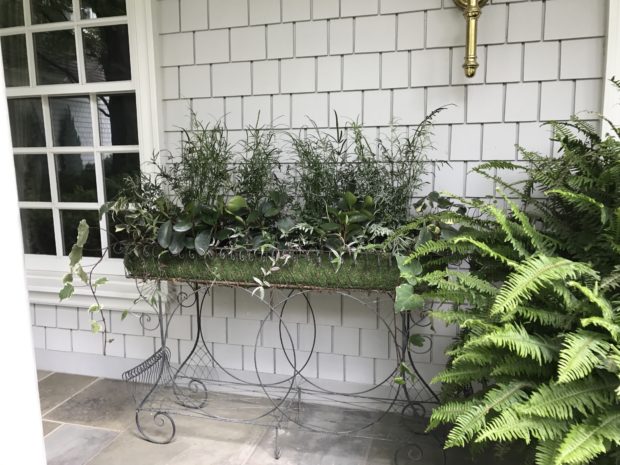 The wire planters on the front porch are planted fresh every year. We redo the moss lining before we plant. This planting of white Victorian parlor ferns, broad leaved pepperomias, variegated ivy, and variegated tradescantia respects and features the detailed iron filigree of the container. The planter is a delicate foil for the mass of the Kimberly Queen fern. A side note on the Kimberlys – taking the time to pull the past year’s fronds for the new fronds coming on keeps them vigorous and fresh looking.
The wire planters on the front porch are planted fresh every year. We redo the moss lining before we plant. This planting of white Victorian parlor ferns, broad leaved pepperomias, variegated ivy, and variegated tradescantia respects and features the detailed iron filigree of the container. The planter is a delicate foil for the mass of the Kimberly Queen fern. A side note on the Kimberlys – taking the time to pull the past year’s fronds for the new fronds coming on keeps them vigorous and fresh looking.
 The back yard terrace and pool yard is home to a number of containers. Each one chosen and placed over the years. A pair of stone planter boxes that finish off a pair of seat height stone and brick walls are a feature of this terrace. This year’s planting does include white nicotiana and purple and white bicolor nicotiana, in addition to the green carex “Everest” and variegated licorice. A little color contrasts with the collection of primarily green plants.
The back yard terrace and pool yard is home to a number of containers. Each one chosen and placed over the years. A pair of stone planter boxes that finish off a pair of seat height stone and brick walls are a feature of this terrace. This year’s planting does include white nicotiana and purple and white bicolor nicotiana, in addition to the green carex “Everest” and variegated licorice. A little color contrasts with the collection of primarily green plants.
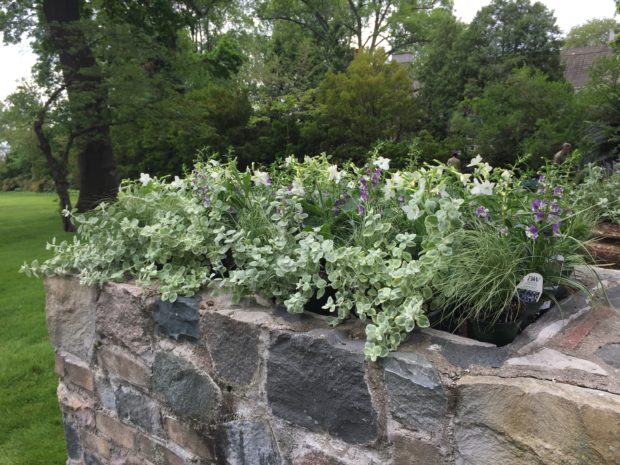 I draw or write the schemes for most of the containers I plant on paper, or on a photograph of the planting from the previous year. But these planters, and 3 others, I lay out when I get there. After so many years, I have an idea of how many plants to take, and how many more to add so I am sure I have enough material. But it takes being there to determine how the plants will go together.
I draw or write the schemes for most of the containers I plant on paper, or on a photograph of the planting from the previous year. But these planters, and 3 others, I lay out when I get there. After so many years, I have an idea of how many plants to take, and how many more to add so I am sure I have enough material. But it takes being there to determine how the plants will go together.
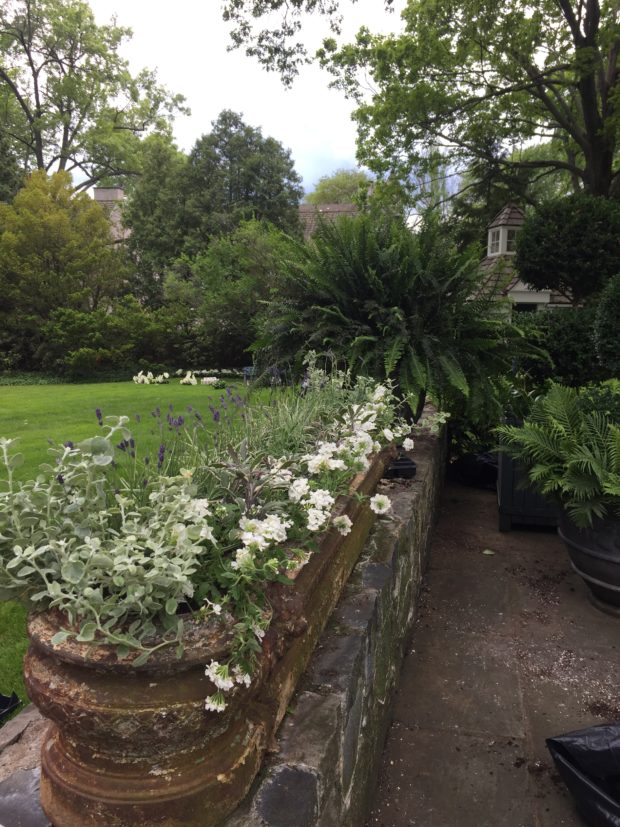 A pair of antique cast iron planters that sit on the walls got the same treatment. I know what plants I will use, but not how I will plant them until I am standing there. The placing can go fast or slow.
A pair of antique cast iron planters that sit on the walls got the same treatment. I know what plants I will use, but not how I will plant them until I am standing there. The placing can go fast or slow.
 This year’s planting is a mix of lavender, lanai white trailing verbena, tricolor sage,the white variegated carex “Everest” and variegated licorice. The planting is fairly low and does not obstruct the far view. I recommend collecting a group of plants that you like (that share the same optimal conditions for growth) and arrange them until you get a composition you like. This approach will help to make clear if something is missing from the mix.
This year’s planting is a mix of lavender, lanai white trailing verbena, tricolor sage,the white variegated carex “Everest” and variegated licorice. The planting is fairly low and does not obstruct the far view. I recommend collecting a group of plants that you like (that share the same optimal conditions for growth) and arrange them until you get a composition you like. This approach will help to make clear if something is missing from the mix.
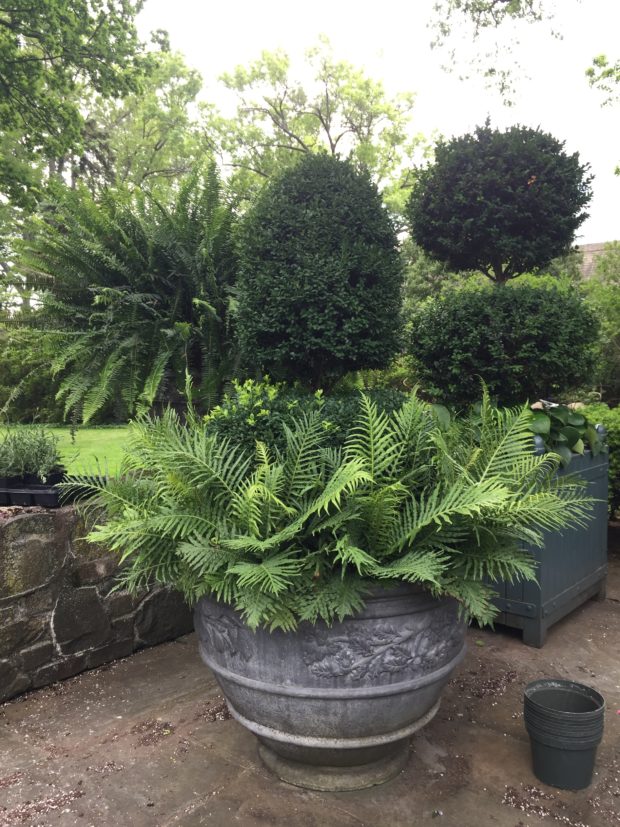 A majority of the containers are summer homes of a collection of topiary plants. These two boxwood topiaries have been part of the collection a good many years. The containers are large, and we do some judicious root pruning at planting time. The only way to obtain boxwood topiary of this size is to grow them yourself. Evergreens in pots can be wintered over in Michigan, but it is not easy. It is tough to get the watering right, and a fiercely cold and windy winter can damage or kill the hardiest of boxwood. No matter the size of the containers, the roots are still above ground. These boxwood are put in an unheated greenhouse space for the winter. The pot in the foreground is under planted with silver ferns. In the back, the big glossy leaves of pepperomia “Jayde” is a textural contrast to the small leaves of the boxwood.
A majority of the containers are summer homes of a collection of topiary plants. These two boxwood topiaries have been part of the collection a good many years. The containers are large, and we do some judicious root pruning at planting time. The only way to obtain boxwood topiary of this size is to grow them yourself. Evergreens in pots can be wintered over in Michigan, but it is not easy. It is tough to get the watering right, and a fiercely cold and windy winter can damage or kill the hardiest of boxwood. No matter the size of the containers, the roots are still above ground. These boxwood are put in an unheated greenhouse space for the winter. The pot in the foreground is under planted with silver ferns. In the back, the big glossy leaves of pepperomia “Jayde” is a textural contrast to the small leaves of the boxwood.
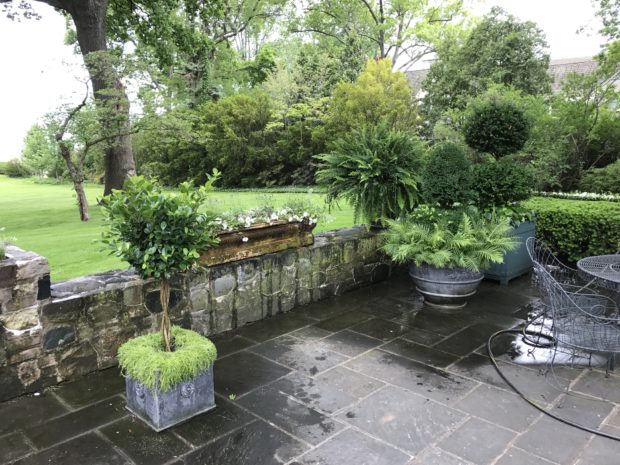 In the foreground is a paddle leaved ficus with a braided trunk – charming. It is under planted with white flowering thyme. Another large Kimberly fern is planted in a pot that sits on top of the wall.
In the foreground is a paddle leaved ficus with a braided trunk – charming. It is under planted with white flowering thyme. Another large Kimberly fern is planted in a pot that sits on top of the wall.
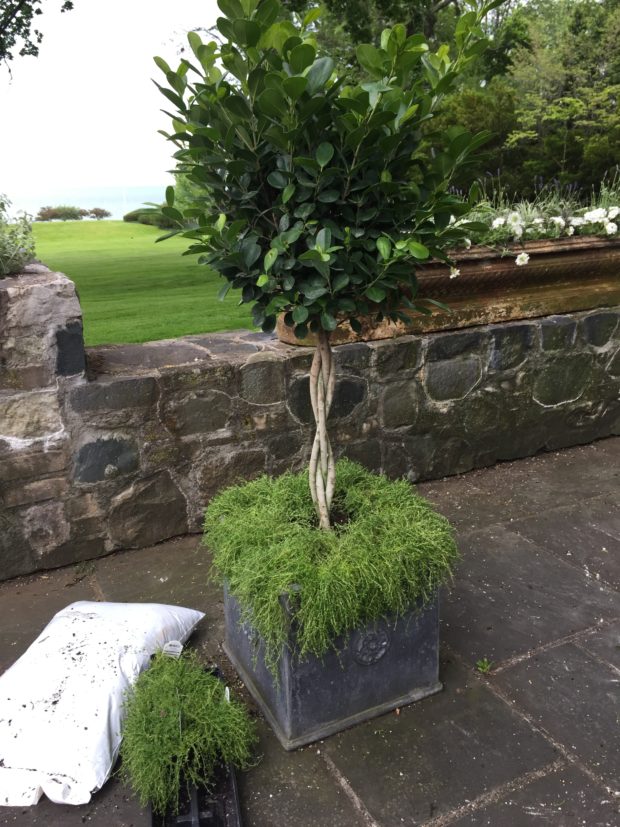 This ficus is a variety that is new to me, and new to this collection. No topiary plant lives for decades, so any collection has to be updated regularly. I hope we can manage to keep this one happy for a while. That won’t be simple. A tropical plant grows at a much faster rate than a boxwood. There will come a time when it no longer fits this container, or it becomes overgrown in an unattractive way.
This ficus is a variety that is new to me, and new to this collection. No topiary plant lives for decades, so any collection has to be updated regularly. I hope we can manage to keep this one happy for a while. That won’t be simple. A tropical plant grows at a much faster rate than a boxwood. There will come a time when it no longer fits this container, or it becomes overgrown in an unattractive way.
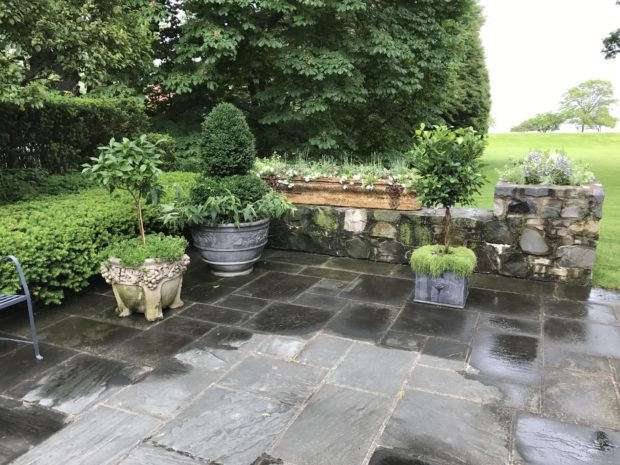 The opposite corner has another new topiary – a lemon tree. We under planted it with parsley. The boxwood topiary is under planted with tibouchina, which will bloom with large blue/purple flowers if the season is long and hot enough. If not the felted green leaves are beautiful.
The opposite corner has another new topiary – a lemon tree. We under planted it with parsley. The boxwood topiary is under planted with tibouchina, which will bloom with large blue/purple flowers if the season is long and hot enough. If not the felted green leaves are beautiful.
 Closer to the boxwood hedge which encloses the fountain is a collection of pots clustered around an antique English double sided bench. The footed pots had for many years been home to a pair of variegated boxwood that finally succumbed. In their place this year, Chicago figs, and crinkle leaf pepperomias.
Closer to the boxwood hedge which encloses the fountain is a collection of pots clustered around an antique English double sided bench. The footed pots had for many years been home to a pair of variegated boxwood that finally succumbed. In their place this year, Chicago figs, and crinkle leaf pepperomias.
 Four steel boxes from Branch anchor the north and south side of the terrace. I always plant all four with white mandevillea, although the under planting may change. At the four corners of the boxwood rectangle, 4 English made wood boxes. They are planted this year with spikes (the most underrated of all the green container plants), white XXL dahlias, sky blue and white petunias, and variegated licorice.
Four steel boxes from Branch anchor the north and south side of the terrace. I always plant all four with white mandevillea, although the under planting may change. At the four corners of the boxwood rectangle, 4 English made wood boxes. They are planted this year with spikes (the most underrated of all the green container plants), white XXL dahlias, sky blue and white petunias, and variegated licorice. 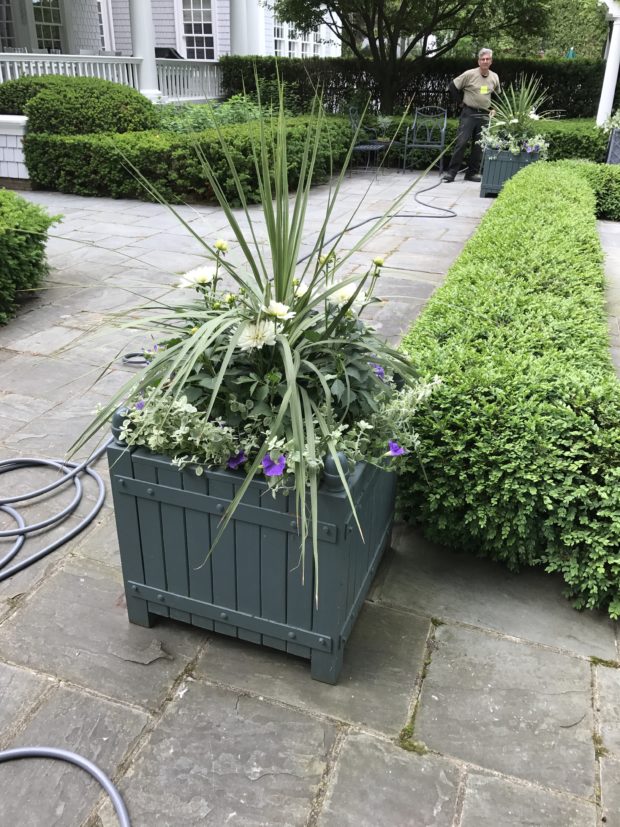 This is a traditional and formal container planting that is appropriate for the place.
This is a traditional and formal container planting that is appropriate for the place.
 The new plant in the steel containers is not blooming yet. Felicia amelloides, or blue daisy bush, will provide a small touch of color.
The new plant in the steel containers is not blooming yet. Felicia amelloides, or blue daisy bush, will provide a small touch of color.
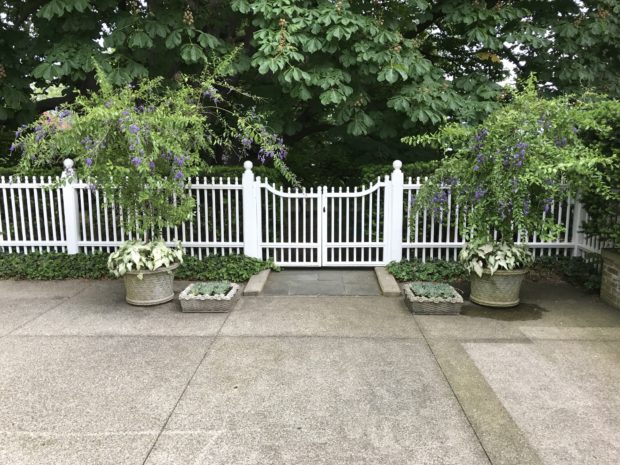 This is the third year for the Duranta on standard. They do not lend themselves to formal pruning, which is good. They have a graceful if irregular natural shape.
This is the third year for the Duranta on standard. They do not lend themselves to formal pruning, which is good. They have a graceful if irregular natural shape.
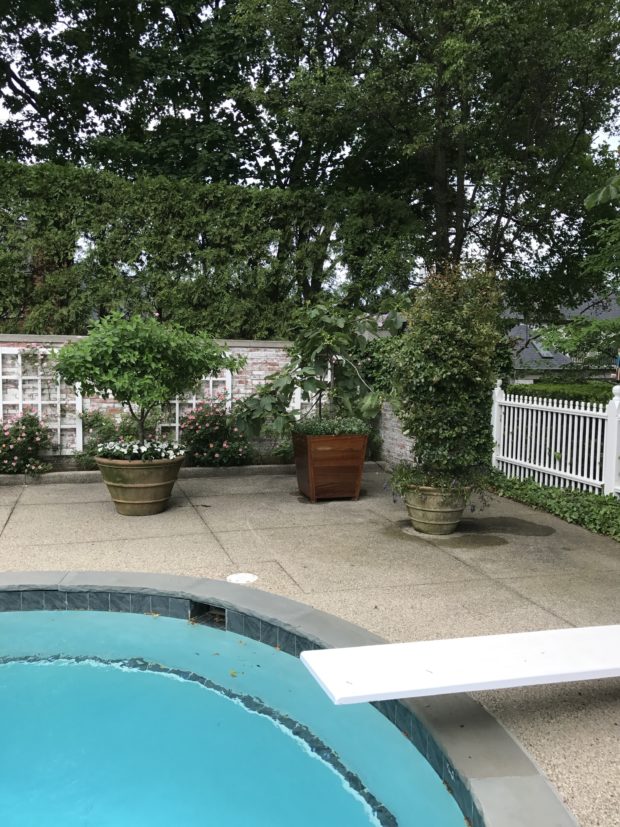 Limelight hydrangea on standard, fig, and eugenia topiary
Limelight hydrangea on standard, fig, and eugenia topiary
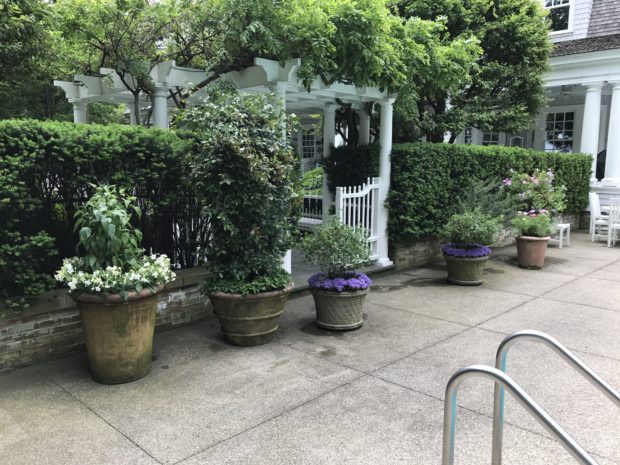 The far left pot has a 1 gallon size black and blue salvia which is under planted with a dwarf nicotiana. The topiaries (not yet pruned for the season) include a eugenia, a pair of white lantana, an old rosemary, and at the last, a scented geranium on standard.
The far left pot has a 1 gallon size black and blue salvia which is under planted with a dwarf nicotiana. The topiaries (not yet pruned for the season) include a eugenia, a pair of white lantana, an old rosemary, and at the last, a scented geranium on standard.
 The terra cotta long tom is planted with mixed sonata cosmos. The topiary underplantings are simple.
The terra cotta long tom is planted with mixed sonata cosmos. The topiary underplantings are simple.
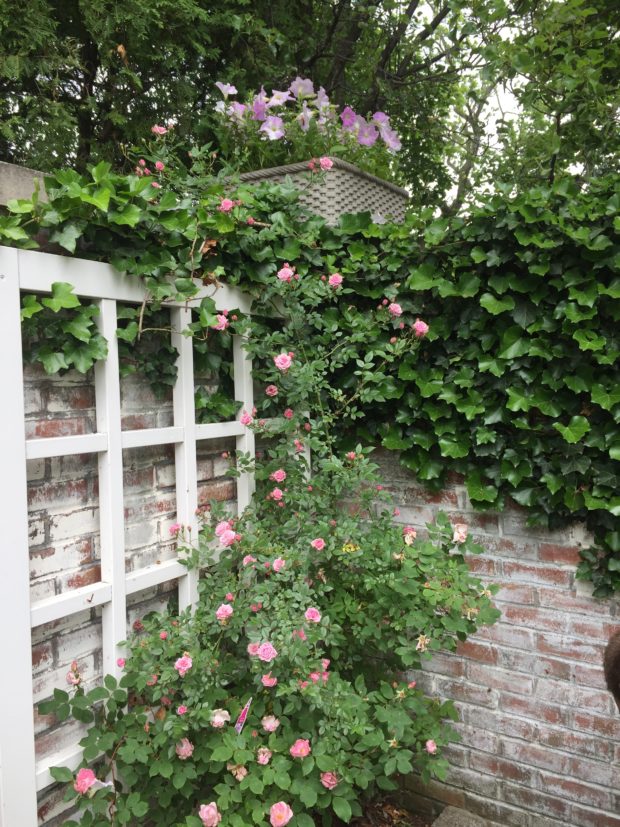 limestone planter on top of a wall
limestone planter on top of a wall
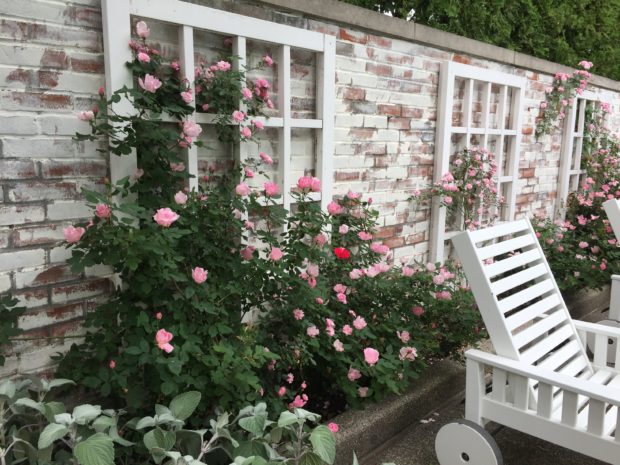 When we get to this corner of the pool yard, I know we are just about ready to wrap it up. How fortunate to have a project like this to plant.
When we get to this corner of the pool yard, I know we are just about ready to wrap it up. How fortunate to have a project like this to plant.
